How do I find the directrix and focus of a parabola with axis that is not parallel to either of the coordinate axis.
The exact que I am trying to ans is –
Find the directrix and focus of the parabola
$9x^{2} + 24xy +16y^{2} – 100x +150y + 325 = 0$
Note: I am looking for a proper method. I did solve it by guess work and I don't want that.

Best Answer
Following the method in this question, we first rewrite the equation as $$(3x+4y)^2=100x-150y-325\tag1$$ and then add $(3x+4y+\alpha)^2-(3x+4y)^2=6\alpha x+8\alpha y+\alpha^2$ to both sides, obtaining $$(3x+4y+\alpha)^2=(6\alpha+100)x+(8\alpha-150)y+(\alpha^2-325).\tag2$$ We then need to find an $\alpha$ such that the lines $3x+4y+\alpha=0$ and $(6\alpha+100)x+(8\alpha-150)y+(\alpha^2-325)=0$ are perpendicular. This will give us the parabola’s axis and tangent at the vertex, respectively. Setting the dot product of the normals to these two lines to zero, we have the equation $$3(6\alpha+100)+4(8\alpha-150)=0$$ with solution $\alpha=6$. Substituting into (2) produces $$(3x+4y+6)^2=17(8x-6y-17).\tag3$$ We take these two lines as our $Y$- and $X$-axes, respectively, with an eye toward using the standard equation $Y^2=4pX$ (essentially the method in lab battacharjee’s now-deleted answer). There’s one more adjustment to be made first, however: the length scales of the two axes need to be the same. This can be done by pulling a factor of two out of the right-hand side, i.e., $$(3x+4y+6)^2=34\left(4x-3y-\frac{17}2\right),\tag4$$ from which $$X=4x-3y-\frac{17}2 \\ Y = 3x+4y+6 \\ p = \frac{17}2.$$ The equation of the directrix is $X=-p$, i.e., $4x-3y=0$, and the focus is $(X,Y)=(p,0)$. Solving the latter system of equations for $x$ and $y$ gives $(2,-3)$.
Note that there might need to be one other adjustment to the equation before reading off the parameters: we want the new coordinate system to be right-handed, which could require changing the signs of one of the two linear expressions. It’s easiest to do this for the squared term since you don’t need to add a compensating negation outside of the term.